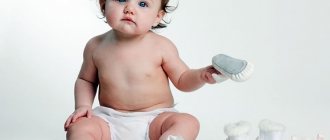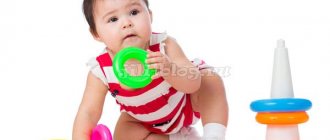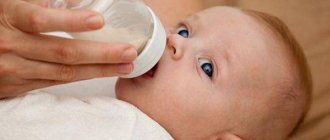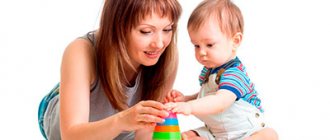Physical changes
By the eleventh month of life, the baby’s muscular system had completely strengthened. He can stand up without support and walk. Over time, he will hone this skill. The second incisors begin to appear. Typically, children grow four teeth by this age. Don't worry if you have fewer teeth or no teeth at all. This is normal for up to a year.
Weight, height and nutrition are important for the proper development of a child at 11 months. On average, babies gain about 400 g in four weeks. They grow by about 1.5 cm. We must not forget that everyone has their own pace and small differences are not scary.
Pediatricians use special tables that were compiled after studying a large number of babies. According to the indicators of WHO specialists, the lower norm for a boy’s weight is 7600 g, the upper norm is 11700 g. For girls, the requirements are different: the minimum weight is 6900 g, the maximum is 11200. Significantly exceeding the indicators is fraught with obesity, which is clearly not healthy at this age.
The data can be seen clearly in the table below:
| Index | Bottom line | Upper limit |
| Boys' weight, kg | 7,6 | 11,7 |
| Girls' weight, kg | 6,9 | 11,2 |
| Boys' height, cm | 69,9 | 79,2 |
| Girls' height, cm | 67,7 | 77,8 |
| Boys' head circumference, cm | 43,2 | 48,3 |
| Head circumference of girls, cm | 41,9 | 47,3 |
Experts in Russian pediatrics adhere to slightly different standards:
| Index | Bottom line | Upper limit |
| Boys' weight, kg | 8,6 | 11,2 |
| Girls' weight, kg | 8,3 | 10,5 |
| Boys' height, cm | 71,3 | 78,0 |
| Girls' height, cm | 70,1 | 76,5 |
Growth is also controlled. For boys, the lower limit is 69.9 cm, and the upper limit is 79.2 cm. For girls, other values are acceptable. The minimum limit is 67.7 cm, the maximum is 77.8 cm.
Physical development
A 10 month old baby can:
- can sit confidently, stand firmly on his legs, holding onto a support with one hand;
- walk leaning on any object or wall (chair, typewriter, side of the crib, etc.);
- climbing a short staircase (in a house or on a slide) takes 2-3 steps, but going down is usually worse;
- sit down from a standing or lying position and stand on your feet, holding onto a support;
- most likely he already has 4 teeth, but if they are not there yet, then this is not a reason for concern, this is also the norm;
- manipulate toys (open and close boxes, hide toys in them, throw them, throw them off the table);
- turning the thick pages of books;
- eat with a spoon, drink from a mug;
- grasp objects with your fingers (“tweezers grip”);
- understand what a pot is and what it is needed for.
Advice! Pediatricians recommend playing with a potty (planting various plush animals on it), but not teaching a child to use it for its intended purpose until one and a half years old, since only by this age children are physiologically able to control their natural processes.
Each child develops through games, which become more and more meaningful every month:
- A 10-month-old toddler rolls a ball, assembles a pyramid, and carries a car. Thus, he begins to understand that the ball is rolling, the cube is standing. If earlier he destroyed the pyramid, now he can assemble it and understand how it is done;
- plays “hide and seek”, “peek-a-boo”, when the baby covers his eyes with his palms or hides behind objects and laughs funny when his parents cannot detect him for a long time and finally find him;
- play various finger games, and they, in turn, perfectly develop fine motor skills;
- is extremely interested in household items (first of all, he puts dishes in them, “cooks”, knocks and other manipulations), tries to imitate his mother in washing the floors and other household chores.
Development calendar from 10 months to a year
| Skills | 10 months | 11 months | 12 months |
| Physical | Can stand for some time without support or support, takes steps while holding handrails | Stands well without support for about 5 seconds, balancing; walks confidently with the support of an adult | Walks independently, can squat, pick something up from the floor, rarely losing balance |
| Speech | Repeats syllables after adults, babbles in “his own language”, speaks some words clearly | Able to fulfill individual requests of an adult related to his usual environment (take a toy, put a plate, etc.) | He makes good contact with an adult who asks him to do something (show him, put him somewhere, bring him, etc.), actively learns new words and tries to pronounce them while still unclear. |
| Thinking | The perception of the world through all sensory channels improves, mental activity becomes more complex, concepts and accompanying judgments are remembered (milk is tasty, the sun is yellow, etc.) | Begins to control his actions, thinks before taking an action, thinking improves | Begins to be aware of the categories of objects, their types (family, food, animals, books, etc.), can hold attention to the object arbitrarily |
Mental development
Minor changes occur in the emotional-volitional sphere. The baby ceases to be part of the mother and moves more and more towards a separate personality. The baby becomes an independent person with his own needs and desires. The child tries to do the same actions as adults. For example, he watches his mother comb her hair and tries to imitate her hand movements.
The baby's speech is filled with babbling words. Common people call this random combination of syllables and sounds “bird language,” but in fact it is already a conscious designation of surrounding objects by certain sound complexes, for example: bee-bee is a car, woof-woof is a dog; Also, with their help, the baby tries to show his desires and needs.
Building a pyramid or a tower from cubes is what a child can already do at 11 months. The development of his thinking depends on what objects and how he comes into contact. Many modern toys are designed to stimulate a child’s cognitive activity: musical farms, sorters, busy boards.
The emotional sphere also undergoes certain changes. The child consciously reacts to his parents. If he feels angry, he tries to bite or hit adults. When feeling joy, he laughs or claps his hands. At this time, it is time to teach him to separate emotions and actions. For example, you can feel angry, but you cannot hit or bite someone.
General features of development
When analyzing a child’s health, it is not necessary to classify symptoms. It is enough for parents to make sure that their child has the following skills:
- Ability to sit independently and play with toys;
- Using a potty;
- Purposeful crawling on the floor;
- Rising to your feet with support on the walls;
- Imitation of facial expressions, gestures and sounds;
- Walking with the support of a senior;
- Simple games with rings and cubes;
- Overcoming small hills (for example, pillows);
- Meaningful use of interjections;
- Possibility to eat and drink from dishes;
- Fulfilling simple requests;
- Association of words with objects;
- Laughter;
- Reaction to one's own name;
- Ability to throw large objects and pick up small ones with fingers;
- Understanding the words “no” and “cannot”;
- Contact with other children;
- The ability to choose between two objects of the same type (shovels, cars, sweaters).
The listed features are required. If a baby is not crawling at 10 months, he can still learn to walk, but he will miss an important stage in his development. If serious difficulties arise, it is better for parents to immediately contact a specialist.
Differences between boys and girls
The physical and mental development of boys and girls is almost the same. However, observant parents may find slight differences in their children's behavior.
Thus, girls prefer monotonous, measured and leisurely games; they sit quietly in one place for a long time. Boys are more difficult to sit down; they are active and love everything noisy. They get along well with their peers.
Trying to walk and talk is what a baby should be able to do at 11 months. Girls usually master these skills faster. Boys are often late in mastering them. Representatives of the stronger sex are highly inquisitive. Moms just have to manage to get them from different parts of the apartment.
Social skills
At 10 months, children acquire some social skills. These include the following behavioral characteristics of the child:
- Children listen to the speech of others. They try to parody what they hear, repeating simple words and sounds. The child begins to understand many of them and tries to relate them to objects. For example, when he hears “mama,” he thinks about his mother. The baby also knows his name.
- Children actively imitate adults. They actively copy their gestures and movements. Parents should be more careful, because a baby can adopt both good and bad behavior patterns. If your baby picks up a dubious habit at this time, it will be quite difficult to wean him off later. On the other hand, this can be used to teach the game. If elders show a child how to roll a car or cradle a doll, he will be willing to repeat it. He won't learn this on his own.
- Hand motor skills are an important part of development. At 10 months, the child should be able to play with small toys. In addition, at this age they attract him more than large ones. Small objects are quite dangerous - they can get into the mouth, nose, or be swallowed, which will lead to asphyxia. But this is not a reason to give up small toys. You just need to keep an eye on your baby while playing, because such a ban will negatively affect the development of motor skills.
- Although the child is still too young for kindergarten, he is already showing interest in other children. He likes to play on the playground with his peers.
The skills listed apply to both boys and girls. A child at 10 months should be able to use touch, smile and gestures. They are his main means of contact with both other kids and adults.
Development of basic skills
The child has good control over his body. In addition to the fact that he can already walk, it is easy for him to get toys from the floor. He will bend down or crouch behind them. He likes music and moves rhythmically to its beat.
The main skill of a child at 11 months is manipulative activity. The baby easily takes toys in his hands, opens his palm taking into account the size of the object. Able to grasp small things with two fingers.
The child likes books. He carefully studies the illustrations and points his finger at the characters. Capable of various actions upon request. For example, wave your palm, rock a doll, make “okay” gestures. Can find toys hidden in a box or bed.
Fine motor skills are improved. The baby can unzip the zipper, put on his shoes, take off his socks and much more. He becomes more and more independent: he begins to eat with a spoon, brush his teeth, and wash his face. If he needs some item, he points his finger at it, says “give me” and shakes his head.
Skills and abilities at 10 months
- The baby independently takes a sitting position and remains in it for quite a long time (more than 10 minutes). Can play while sitting, communicate and try to reach high lying objects.
- Leaning on walls or furniture, the baby briefly stands up on his knees or even his legs. If you hold your baby by the hand, he will try to take a few steps. Can take several steps, pushing a chair or a small support in front of a friend. In this way, the child develops his musculoskeletal system and prepares for future walking.
- Actively moves by crawling. At nine months, the baby continues to master crawling on all fours, but for most it is difficult, so they often crawl “on their bellies.” In connection with this, it is necessary to take care of the maximum safety of his surroundings: move all dangerous objects to his access zone, make sure that he cannot drop anything, and monitor the cleanliness of surfaces.
- Develops a “tweezer” grip. The child learns to grasp toys not only with the help of the entire palm, but also using only the thumb and forefinger. Skillful use of such a grip is a sign of good development of the child’s fine motor skills and high rates of mental development. The baby will constantly touch everything around him, try to knock it over, break it or tear it, so you need to be careful. Also at this time, the baby will begin to use one hand more often than the other. You should not try to retrain him, as this can only harm the child’s development.
- At ten months, a child can learn to crawl off beds, sofas and other low furniture. It is necessary to carefully monitor its movements, especially on high surfaces.
- One of the child's activities is to imitate adults. He can repeat the movements of his mother in the kitchen or his father at work. By studying and remembering the movements of adults, the child learns about the world around him.
- The child understands the purpose of “complex” toys. For example, he will not throw or hit balls, toy cars and similar toys, but will roll them along the floor.
Sample meal plan
At 11 months, the child should receive complete complementary foods. This is done regardless of breastfeeding or artificial feeding. The baby’s body is already ready for new foods and tastes. He doesn’t have to mash it, just boil the vegetables and mash them with a fork. Gradually, he becomes accustomed to biting off pieces.
Feeding should be based on the following rules:
- Meals - five times a day;
- There is a maximum of 4.5 hours difference between them;
- It is advisable to feed at the same time.
At this age, boiled vegetables and fruits (chopped), meat, and curds are given. Priority is given to steaming or stewing. It is undesirable to add sugar, spices and starch. Be sure to include different cereals.
Parents should carefully monitor the baby's reaction as he begins to form certain taste habits. He may not like some foods, and this is normal. Allergens are excluded from the child's menu. These may include the following products: citrus fruits, honey, chocolate, exotic fruits, nuts. Do not give undiluted cow's milk. Cookies are issued in limited quantities.
Don't try to figure out the perfect serving size. Focus on the child's needs. If he doesn’t want to finish eating, then you shouldn’t force food into him. He may perceive some dishes negatively, especially if they are new. There is no need to be zealous; you can repeat the acquaintance after some time. Remember that appetite increases after a walk or taking water procedures.
Psycho-emotional development at 10 months
- The child begins to fully understand speech. He can repeat some simple words and sounds. The child also develops strong associations between the spoken word and the object: if an adult names an object, the child will point to it. During a conversation, the intonation of the voice may noticeably change.
- A primitive sense of humor appears. The child will be able to understand the simplest jokes and laugh. Having a sense of humor is a sign of intellectual development.
- Imitation of the actions of parents plays a significant role in a child’s understanding of the world around him.
- Shows emotions clearly. If you try to make a child laugh or praise him, he will be sincerely happy; if you offend or punish the child, he will get angry.
- Can answer yes/no questions with a nod of the head, say goodbye and greet with waves of the hand. The baby also understands simple phrases when he is offered something or asked to come over.
- Helps parents while changing clothes. Can independently pull on or remove a cap from his head
- At nine months, the baby still has very sensitive hearing. Do not turn on loud household appliances in front of him and do not allow unnecessary noise in his environment. But at the same time, you should not leave your baby to sleep in complete silence, as the child may get used to sleeping in such conditions and the slightest noise will wake him up in the future.
- A child can play alone for quite a long time. It is very easy for him to engage himself in a certain activity and not be distracted for a long time. Moreover, if adults distract him for a while, then, when freed, the child will return to his occupation.
- The child constantly experiments with toys and most often does not use them for their intended purpose. He can test them for strength, put them in one pile or another, throw them and pick one toy with another.











